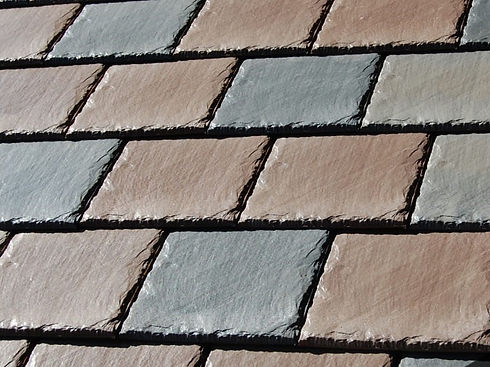Roof, Insulation, and Ventilation
A building envelope is the boundary between the interior and the exterior of a building. It is one of the most important aspects of building design due to its role in the maintenance and protection of a structure.
Roof Types

ASPHALT SHINGLES
Asphalt shingles are composed of heavy organic or inorganic felt saturated with asphalt and covered in mineral granules (sand-type material). Asphalt shingles perform better than fiberglass shingles in cold climates. However, asphalt shingles are less durable than other types in hot climates.

FIBERGLASS SHINGLES
Fiberglass shingles are composed of a fiberglass mat saturated with asphalt and covered in mineral granules (sand type-material). Fiberglass shingles perform better than asphalt shingles in wet climates, are more fire-resistant, and are the go-to choice in hot climates. However, fiberglass shingles are less durable in cold climates.

COMPOSITE SHINGLES
Composite shingles, sometimes referred to Polymer Composite or Synthetic shingles, are made from engineered materials and may be comprised of a mixture of recycled plastics and rubber. They come in many different styles and profiles, and are made to replicate the look of traditional asphalt shingles, wood shakes, and stone tiles. Composite shingles are much more durable than asphalt or fiberglass shingles and also require less maintenance.

SHEET METAL
Metal roofs have a higher initial installation cost but can last for many decades.

WOOD (SHAKES OR SHINGLES)
Wood shakes and shingles are cedar and are typically utilized for traditional or historical-style homes. However, cedar shakes and shingles have declined in popularity due to their obvious lack of fire-retardant properties. A better choice is composite roof products that come in styles that resemble wood shakes but are resistant to fire.

CLAY TILES
Clay tiles are expensive, heavy, and come in two styles: mission style and shingle style. In addition, if you want to convert from an asphalt or fiberglass roof to a clay roof, your house may have to be structurally fortified to support the increased weight of the clay tiles.

SLATE
Slate is an expensive natural stone material. In addition, if you want to convert from an asphalt or fiberglass roof to a slate roof, your house may have to be structurally fortified to support the increased weight of the stone. In modern construction, composite shingles in a slate style are typically used instead of natural stone.

BITUMINOUS MEMBRANE
A bituminous membrane is a build-up of layers of asphalt-impregnated roofing felt and hot asphalt.

SINGLE-PLY MEMBRANE
Single-ply roof membranes are sheet materials that are applied to the roof in a single layer (covering).

FLUID-APPLIED MEMBRANE
This is your Service description. Use this space to describe what the service entails, benefits for users and any other important information. Have a lot to say? Easily turn any item into a full page by clicking ‘Create a page from this item’ in the edit panel.
Insulation and Ventilation
Thermal insulation is an important component of a building envelope, and if properly installed, results in a reduction of the amount of energy required to heat or cool a home throughout the year. The quality of the windows and doors also contribute to the reduction of energy consumption.
When designed properly, the building envelope allows for the ventilation of fresh air and protects the structure from air leakage at the same time. Weather conditions such as strong winds can increase the amount of air that escapes through the envelope, particularly if the envelope and windows/doors are not sealed correctly.

BLOWN-IN INSULATION
Blow-in insulation is made from either cellulose or fiberglass.

SHEET INSULATION
Sheet insulation is typically made from fiberglass.

VENTILATION
This is your Service Description. Use this space to explain this service in more detail.

VAPOR BARRIER
In modern construction, a layer of material that controls airflow and water intrusion is referred to as a vapor barrier. It is typically installed over the plywood layer of the exterior walls before the installation of windows and doors. A brand of vapor barrier used in this application is Tyvek.
